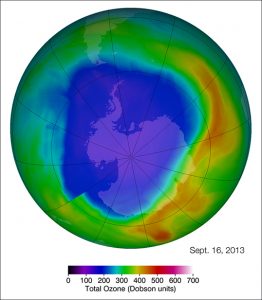Climate Change, Ozone Depletion, and the New York Times
The Montreal Protocol offers lessons for climate change, but not a role model
In an extended piece yesterday, The New York Times editorial board wrote that “The World Solved the Ozone Problem. It Can Solve Climate Change. The same tools that fixed the ozone hole — science, innovation and international action — can address.” Although the editorial was mostly correct, it missed what I believe to be the key differences between the two global environmental challenges.
 The similarities between stratospheric ozone depletion and anthropogenic climate change are clear. Both are caused by (mostly) industrial gas emissions whose accumulation globally alters the atmosphere and poses significant risks for future generations. Ending them presents collective action problems, in which each state’s emissions reductions would create net global benefits but impose net local costs. Consequently, “free riding” on others’ effort is a legitimate concern and serious limitation.
The similarities between stratospheric ozone depletion and anthropogenic climate change are clear. Both are caused by (mostly) industrial gas emissions whose accumulation globally alters the atmosphere and poses significant risks for future generations. Ending them presents collective action problems, in which each state’s emissions reductions would create net global benefits but impose net local costs. Consequently, “free riding” on others’ effort is a legitimate concern and serious limitation.
The Montreal Protocol (to the Vienna Convention for the Protection of the Ozone Layer) — which successfully phased out the production of ozone-depleting substances through differentiated targets and timetables — was a model for the climate change regime of the Intergovernmental Panel on Climate Change, the UN Framework Convention on Climate Change, and the Kyoto Protocol. Yet the latter is largely considered to be a disappointment, and the entire climate regime has failed to yield the necessary aggressive emissions cuts.
Why were countries able to overcome the global collective action problem of ending the production of ozone depleting substances but are not able to do so with greenhouse gases? The New York Times editorial gives three reasons.
First, it says “there were no relatively expeditious technological fixes for carbon emissions, as there were for [chloro]fluorocarbons,” the leading ozone-depleting substances. This is important: the same few firms that produced ozone-depleting substances had substitutes that were available or “in the pipeline” of development. In contrast, fossil fuels have no obvious replacement with similar concentration and portability of energy, wind and solar energy are intermittent, and nuclear power faces deep public opposition.
Second, “despite predictable industry warnings of economic ruin, the efforts to protect the ozone layer… faced nowhere near the campaign of denial and disinformation mounted by… fossil fuel companies .” In the case of ozone-depleting substances, this was a result of substitutes’ availability and the industry’s relative small size. The substances were used for only a few modest industrial purposes, such as coolants and propellants, and the firms were diversified, producing other chemicals. In the case of fossil fuels, they are used in and are essential to a broad swath of economic activities: energy production, transportation, agriculture, industrial processes, and heating. And many large business rely (nearly) solely on fossil fuels for their revenue.
Third, The New York Times cites “the absence, until fairly recently, of obvious environmental damage [from climate change] threatening individual well-being and the sense of urgency that inspires the public to demand regulatory responses. The prospect of thousands and even millions of cancer deaths led to the Montreal Protocol.” I am unsure about the truth of this. Stratospheric ozone depletion’s leading risk was that of skin cancer, which would manifest in the future, like climate change’s impacts. Instead, I would emphasize that cancer seemed more salient — almost everyone in industrialized countries knows someone who has died from it — while climate change’s expected impacts “feel” less real. Few of us know someone directly who has died from rising sea levels or, for that matter, a flood or hurricane.

However, in my assessment, the primary differences between stratospheric ozone depletion and anthropogenic climate change concern the interests of states (i.e. countries). These manifest in two ways. First, the emitters of ozone-depleting substances and the likely future victims of stratospheric ozone depletion were the same: industrialized countries whose high-latitude locations placed them close to the growing ozone “holes,” which were at the poles and expanding. In fact, these countries began to phase out ozone-depleting substances before the Montreal Protocol did so internationally. That agreement was necessary to prevent low-latitude countries from beginning to produce the substances in order to seize an economic opportunity. While the greatest per capita greenhouse gas emitters are also high-latitude industrialized countries, the likely victims of the most severe impacts are low-latitude developing ones. The former lack self-interested reasons to substantially cut emissions, and the latter lack the wealth to limit future emissions while also meeting the development needs of their populations.
Second, benefit/cost ratio of ending the production of ozone-depleting substances was great enough (due in large part to available or likely substitutes) that the wealthy industrialized states could essentially pay developing ones via “technology transfer,” “technological assistance,” and less visible side payments to not allow new ozone-depleting industries to develop. With climate change, the benefit/cost ration of short term, aggressive action is less clear. And as noted, the likely victims are relatively poor, unable to make meaningful side payments to the wealthy emitters.
What lessons can we draw from stratospheric ozone depletion for climate change? For one thing, targets and timetables will not work, as was evident in the Kyoto Protocol’s failure to accomplish much. And unfortunately, we probably should not expect widespread deep emissions reductions under the Paris Agreement. For another thing, the best path to reducing and ending greenhouse gas emissions is the development of genuine, reliable, and profitable substitutes, especially for fossil fuels. This points toward the importance of financial support for research and development. Finally, state and nonstate actors should prepare for climate change through adaptation and solar geoengineering research.






Reader Comments